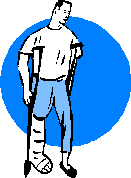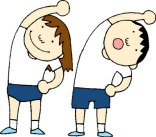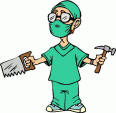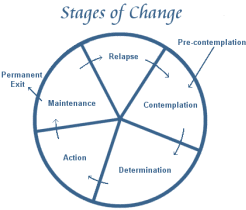The Anatomy of Persistence--How Does Bob Keep Going When Injured?

Transforming injuries into new beginnings—or just begin again and again and again….
Because of my early severe obesity, my body’s musculature is prone to aches, pains and malfunctions. About every 3-5 years I have to change my fitness routine. For example:
· I cherished Jazzercise® (aerobic dancing to music) and did it three times per week for four years. Then all-at-once my feet started hurting me. X-rays revealed that feet have hammertoes and large bone spurs on my left foot, so I couldn’t do it anymore and I needed to get orthodic shoe inserts. I got the hammer toes fixed on the left foot.
· I've been hiking and back packing for many years. On a recent hike I experienced severe pain from my foot joints after just 3 miles of walking. X-rays revealed that my hammertoes have increased and I have large bone spurs on the right foot. I asked the doctor for referral to a podiatrist to get exercise suggestions, foot care ideas, and I also needed to get orthodic shoe inserts for my hiking boots and tennis shoes. Oh no....more changes....
· I started yoga to increase my flexibility, balance and strength. A friend referred me to a qualified teacher, to whom I have practiced with for twelve years. I loved it. I’ve had to stop, at times, due to my knee, feet, and shoulder injuries and pain.


· On a hike I slipped down a hill and severely pulled out my shoulder muscles (rotator cuff) —ouch! I had to see a physical therapist, who recommended a whole series of exercises to build up my shoulder and upper body muscles. My job doesn’t use my upper-body muscles and so they had deteriorated over time. It took about one and a half years to get better. It was at this time that I joined a gym—something that I never wanted to do before. All of the strength-training machines looked like torture machines from outer space. My injury was the triggering event that got me started and I have kept going for about 9 years—for two to three times a week. I also look forward to taking yoga at the club every Tuesday and Thursday. I feel SO good afterwards.
· Then my knees started hurting. X-rays revealed I have arthritis. About four years ago I stopped doing knee exercises because of the pain. I discovered all of my muscles seem to easily waste away without constant strength training and maintenance. After one year, my knee-geometry was thrown off due to weak muscles and a severe pain developed. I could barely walk, and no hiking was allowed. I felt very sad and discouraged. Oh, no. Not another change!

UPDATE! 5 years ago my massage therapist told me that my muscles were all wasting away (at 60 yrs old--now I am 68!). I realized that I needed to change gyms and to do something I had NEVER done before!! I signed up for personal training 2 times per week for 2 years. I learned many new exercises and my strength and muscle tone increased dramatically! I now go to the gym 3 times/week to do strength training. I see the personal trainer 1 time per month now. I do walks every day around my neighborhood and go on hikes regularly:http://www.balancedweightmanagement.com/Frolic%20In%20Nature!.htm
About 12 months ago I started to get sharp pains in my left knee again as I walked up and down hills....my MD had me get X-rays which showed that my left knee now had "bone-on-bone" because the cartilage had worn away...I went to Physical Therapy to get a series of exercises to help out...and my MD said that eventually I will need a knee replacement!!!!!!!!!!!!!!!!!!!! OOPS...ON November 13th 2017 I had a total knee replacement--here are the X-rays!! 2017 TOTAL KNEE REPLACEMENT IMPLANT.pdf I've been doing PT for 12 months now and my knee is much better. It will still require "muscle maintenance" to keep the artificial joint pain-free and functional. I want to be able to garden, walk, hike, and have a FUN life now that I am retired!!! I was also diagnosed with Parkinson's disease--so I have had to learn how to walk all over again--by practicing deep mindfulness and acceptance.

OOPS...another change 14 months ago I started to get fairly intense pain again on the bottom of my right foot when hiking up and down hills. I went to the foot doctor who said I had fairly severe hammer toes (they had gotten worse) that caused my feet to develop large calluses. I needed to go to a orthodic (foot insert) store again to purchase new custom orthodics to correct my present foot problem!!! I did that.
So you can see that my trips to health care professionals left me with things that I needed to do...but how to do them? Why did I want to do them? I wanted to decrease my pain and increase my freedom and enjoyment in life by still creating an active lifestyle!!!!!!!!!!!!!!!!!!!! That IS important to me! I also tried to be my: Be Your Own Medical Advocate
To help me make lasting activity changes, I applied the Stages of Change model.
The Stages of Change:
No one stage is more important than another—it’s a process.
Stage of Change |
Ways to Motivate Change |
|
Pre-contemplation—Not even thinking about changing. |
Increase awareness of the effects of the problem behavior. HOW are your present choices harmful to you or others? Take responsibility. |
|
Contemplation—Beginning to think about risks and benefits of change. |
Many people experience a "triggering event": illness, mental or emotional distress. The goal is to decrease uncertainty about wanting to make changes by identifying pros (benefits to you) and cons (hassles) of change. Are the long-term benefits worth the short-term costs? These times can be filled with guilt, shame, hopelessness, and desperation. See ideas below on how to sort things out. Get support for yourself. |
|
Preparation—Plan for a change, but you don’t know what to do. You begin to think of ways to change. |
Evaluate your life, get advice and help. Seek information: perhaps make phone calls, attend meetings or seminars. You're in the process of gathering tools for yourself. Listen to your "self-talk" about the value to you of making changes. Make an action plan with specific steps. Set a date. Identify rewards. |
|
Action—Making changes. Committing time and energy to practice new behaviors. |
Start small. Set specific, achievable, meaningful, short-term goals. Work to solve problems as they arise. Action is PRACTICE. New behaviors will feel uncomfortable to you at first, and you won't be very skilled at them. You'll make mistakes. New habits are the most "fragile" to revert back to OLD habits during the first 6 months. |
|
Relapse—Returning to former patterns. It will happen. Choose to learn from it. Can last five minutes or five years! |
RELAPSE IS NOT FAILURE. IT IS LEARNING. It can happen at ANY stage, especially between pre-contemplation and contemplation, and during times of crisis. Be kind with yourself and honest. NOTICE what has happened. Determine what you can learn from the experience, and plan ahead for the future. Problem solve: use your knowledge as a tool for your next stage. Keep a journal to notice and unravel patterns. Plan behavior substitutions. Don’t give up. Don't give up. Just begin again! Seek out helpful resources on this web site. |
|
Maintenance—Continuing new behaviors with increased confidence. Have awareness of what triggers a relapse and make plans to avoid it. |
Remind yourself of reasons for having changed--never forget WHY you wanted to do something different. See Bob's story, Emotional Area for examples of reasons. Reevaluate and redefine your tools and your plan. It will get easier to maintain new behaviors over time. Be patient and persistent. Change is a process, NOT an event. Practice self and stress-management skills. Notice if you have fallen back into a chronic, unhealthy patterns again and use the self-evaluation tools (use the Daily Personal Check-In section of this Web site). Congratulate yourself for having the courage to do it! |
Check out too the CDC Physical Activity is for Everyone: http://www.cdc.gov/nccdphp/dnpa/physical/starting/
How did Bob use the Stages-of-Change process to keep going when injured?

· Contemplation: I thought of all the reasons why I just wanted to give up—throw in the towel. I listened to my sad, angry, fearful and frustrated emotions. I then thought of all the reasons why I would benefit from doing the exercises. I talked myself into beginning and congratulated myself for having the courage to begin!
· Preparation: I visited the health resource center and the Internet and got information on arthritis—on what it is–and how I can manage it. I made copies of the exercises to have around the house. I got my yoga mat and belt and the strap-on leg weights and put them in the living room for easy access. I made a date with myself for exercise and put it on the calendar—the days and times. I called up the instructor and put-on-hold my Friday yoga class—since it was too intense for me right now. All of these steps helped me actually DO the exercises.
· Action: I first tried the exercises with the physical therapist. When I got home I did them the best I could—as the pain would allow. I saw the therapist again and discovered I wasn’t doing them all correctly! So, I modified the routine. I needed to look at her written instructions and use an exercise log to remind me of what to do and keep record of my progress. I have a number of different exercises to do on different days of the week. As I am doing the exercises, I have to modify all routines depending on the pain that is present.
· Relapse: “I was exercising until…” My relapse started a year ago, due to arthritis knee pain. Previously, I was doing regular leg exercises at the gym. Within one year, my legs got really out of shape. I learned from this that all muscle groups need a regular workout and that one exercise doesn’t substitute for another. Darn! I can see I will also have to watch getting so busy I forget to schedule time for me. I remember: I did it before and I can do it again.
· Maintenance: After 6 weeks of doing the exercises, my knee is starting to get better! I was actually totally pain-free on a longer walk! I remind myself of the value of doing the exercises and of how they directly contribute to my knee health. I know that if I stop doing them that my muscles will again get weak and the same problem will occur. I remind myself of the pros-and-cons of change. I asked the physical therapist for an exercise prescription for maintenance—because I know that if I don’t use it, I will lose it.
· I also used positive self-talk. I thought about attitude—the attitude of acceptance, patience and appreciation—accepting the weaknesses of my body (and its strengths) and the slow progress I experience. I also practice being my own rooting squad and tell myself, “Good job, Bob! I’m proud of you for your efforts! Keep up the great work!” Also appreciation—I had totally taken for granted the ability to walk and hike—now I don’t. I really treasure my blessings.

Slow and steady wins the race! My boss calls me “Mr. Maintenance.” But really, my strength is persistence. I just begin again and again. I developed the habit of persistence by using the Stages of Change process.
So you can see from my story that long-term fitness requires adjustment for the different ups-and-downs in the different seasons of life. It’s not always easy, but the results of being consistent are worth it.